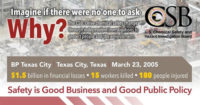 The Chemical Safety and Hazard Investigation Board (CSB) will vote on January 15 on the draft regulatory report of the August 6, 2012, fire at the Chevron refinery that endangered 19 workers and sent more than 15,000 residents to the hospital for medical attention.
The Chemical Safety and Hazard Investigation Board (CSB) will vote on January 15 on the draft regulatory report of the August 6, 2012, fire at the Chevron refinery that endangered 19 workers and sent more than 15,000 residents to the hospital for medical attention.
If it’s approved by the Board, the report will recommend that California “Develop and implement a step-by-step plan to establish a more rigorous safety management regulatory framework for petroleum refineries in the state of California based on the principles of the ‘safety case’ framework in use in regulatory regimes such as those in the UK, Australia, and Norway.” The recommendation urges specific steps to accomplish this, including ensuring that workers are formally involved in the development of a safety case report for each covered facility. The report also urges California to work with industry in gathering refinery safety indicator data to be shared with the public.
A fundamental change
A safety case regime would require companies to demonstrate to refinery industry regulators – through a written “safety case report” – how major hazards are to be controlled and risks reduced to “as low as reasonably practicable,” or ALARP. The CSB report notes that the safety case is more than a written document; rather, it represents a fundamental change by shifting the responsibility for continuous reductions in major accident risks from regulators to the company.
To ensure that a facility’s safety goals and programs are accomplished, a safety case report generated by the company is rigorously reviewed, audited, and enforced by highly trained regulatory inspectors, whose technical training and experience are on par with the personnel employed by the companies they oversee, the CSB draft report says.





.jpg?t=1721257160)
